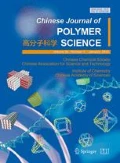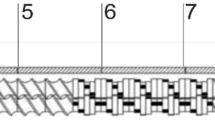Abstract
The objective of this study was to improve the toughness of bio-based brittle poly(ethylene 2,5-furandicarboxylate) (PEF) by melt blending with bio-based polyamide11 (PA11) in the presence of a reactive multifunctional epoxy compatibilizer (Joncryl ADR®-4368). The morphological, thermal, rheological, and mechanical properties of PEF/PA11 blends were investigated. Compared with neat PEF, the toughness of PEF/PA11 blend was not improved in the absence of the reactive compatibilizer due to the poor compatibility between the two polymers. When Joncryl was incorporated into PEF/PA11 blends, the interfacial tension between PEF and PA11 was obviously reduced, reflecting in the fine average particle size and narrow distribution of PA11 dispersed phase as observed by scanning electron microscopy (SEM). The complex viscosities of PEF/PA11 blends with Joncryl were much higher than that of PEF/PA11 blend, which could be ascribed to the formation of graft copolymers through the epoxy groups of Joncryl reacting with the end groups of PEF and PA11 molecular chains. Thus, the compatibility and interfacial adhesion between PEF and PA11 were greatly improved in the presence of Joncryl. The compatibilized PEF/PA11 blend with 1.5 phr Joncryl exhibited significantly improved elongation at break and unnotch impact strength with values of 90.1% and 30.3 kJ/m2, respectively, compared with those of 3.6% and 3.8 kJ/m2 for neat PEF, respectively. This work provides an effective approach to improve the toughness of PEF which may expand its widespread application in packaging.
Similar content being viewed by others
References
Yu, X. L.; Wang, X.; Zhang, Z.; Peng, S. X.; Chen, H.; Zhao, X. P. High-performance fully bio-based poly(lactic acid)/polyamide11 (PLA/PA11) blends by reactive blending with multifunctionalized epoxy. Polym. Test. 2019, 78, 105980.
Gandini, A. Polymers from renewable resources: a challenge for the future of macromolecular materials. Macromolecules 2008, 41, 9491–9504.
Wang, J. G.; Liu, X. Q.; Zhu, J. From furan to high quality bio-based poly(ethylene furandicarboxylate) (PEF). Chinese J. Polym. Sci. 2018, 36, 720–727.
Walha, F.; Lamnawar, K.; Maazouz, A.; Jaziri, M. Rheological, morphological and mechanical studies of sustainably sourced polymer blends based on poly(lactic acid) and polyamide 11. Polymers 2016, 8, 61.
Codou, A.; Guigo, N.; van Berkel, J. G.; de Jong, E.; Sbirrazzuoli, N. Non-isothermal crystallization kinetics of biobased poly(ethylene 2,5-furandicarboxylate) synthesized via the direct esterification process. Macromol. Chem. Phys. 2014, 215, 2065–2074.
Xie, H. Z.; Wu, L. B.; Li, B. G.; Dubois, P. Modification of poly(ethylene 2,5-furandicarboxylate) with biobased 1,5-pentanediol: Significantly toughened copolyesters retaining high tensile strength and O2 barrier property. Biomacromolecules 2019, 20, 353–364.
Codou, A.; Guigo, N.; van Berkel, J. G.; de Jong, E.; Sbirrazzuoli, N. Preparation and crystallization behavior of poly(ethylene 2,5-furandicarboxylate)/cellulose composites by twin screw extrusion. Carbohyd. Polym. 2017, 174, 1026–1033.
Martino, L.; Niknam, V.; Guigo, N.; van Berkel, J. G.; Sbirrazzuoli, N. Morphology and thermal properties of novel clay-based poly(ethylene 2,5-furandicarboxylate) (PEF) nanocomposites. RSC Adv. 2016, 6, 59800–59807.
Sun, L. Y.; Wang, J. G.; Mahmud, S.; Jiang, Y. H.; Zhu, J.; Liu, X. Q. New insight into the mechanism for the excellent gas properties of poly(ethylene 2,5-furandicarboxylate) (PEF): role of furan ring’s polarity. Eur. Polym. J. 2019, 118, 642–650.
Xie, H. Z.; Wu, L. B.; Li, B. G.; Dubois, P. Poly(ethylene 2,5-furandicarboxylate-mb-poly(tetramethylene glycol)) multiblock copolymers: from high tough thermoplastics to elastomers. Polymer 2018, 155, 89–98.
Wang, X. S.; Liu, S. Y.; Wang, Q. Y.; Li, J. G.; Wang, G. Y. Synthesis and characterization of poly(ethylene 2,5-furandicarboxylate-co-µ-caprolactone) copolyesters. Eur. Polym. J. 2018, 109, 191–197.
Wu, J. P.; Xie, H. Z.; Wu, L. B.; Li, B. G.; Duboi, P. DBU-catalyzed biobased poly(ethylene 2,5-furandicarboxylate) polyester with rapid melt crystallization: synthesis, crystallization kinetics and melting behavior. RSC Adv. 2016, 6, 101578–101586.
Wang, J. G.; Liu, X. Q.; Jia, Z.; Sun, L. Y.; Zhu, J. Highly crystalline polyesters synthesized from furandicarboxylic acid (FDCA): potential bio-based engineering plastic. Eur. Polym. J. 2018, 109, 379–390.
Wang, J. G.; Liu, X. Q.; Zhang, Y. J.; Liu, F.; Zhu, J. Modification of poly(ethylene 2,5-furandicarboxylate) with 1,4-cyclohexanedimethylene: influence of composition on mechanical and barrier properties. Polymer 2016, 103, 1–8.
Papageorgiou, G. Z.; Papageorgiou, D. G.; Terzopoulou, Z.; Bikiaris, D. N. Production of bio-based 2,5-furan dicarboxylate polyesters: recent progress and critical aspects in their synthesis and thermal properties. Eur. Polym. J. 2016, 83, 202–229.
Knoop, R. J. I.; Vogelzang, W.; van Haveren, J.; van Es, D. S. High molecular weight poly(ethylene-2,5-furanoate): critical aspects in synthesis and mechanical property determination. J. Polym. Sci., Part A: Polym. Chem. 2013, 51, 4191–4199.
Jiang, M.; Liu, Q.; Zhang, Q.; Ye, C.; Zhou, G. Y. A series of furanaromatic polyesters synthesized via direct esterification method based on renewable resources. J. Polym. Sci., Part A: Polym. Chem. 2012, 50, 1026–1036.
Wang, X. S.; Wang, Q. Y.; Liu, S. Y.; Wang, G. Y. Biobased copolyesters: synthesis, structure, thermal and mechanical properties of poly(ethylene 2,5-furandicarboxylate-co-ethylene 1, 4-cyclohexanedicarboxylate). Polym. Degrad. Stab. 2018, 154, 96–102.
van Berkel, J. G.; Guigo, N.; Kolstad, J. J.; Sbirrazzuoli, N. Biaxial orientation of poly(ethylene 2,5-furandicarboxylate): an explorative study. Macromol. Mater. Eng. 2018, 303, 1700507.
Wang, G. Q.; Jiang, M.; Zhang, Q.; Wang, R.; Zhou, G. Y. Biobased copolyesters: synthesis, crystallization behavior, thermal and mechanical properties of poly(ethylene glycol sebacate-co-ethylene glycol 2,5-furan dicarboxylate). RSC Adv. 2017, 7, 13798–13807.
Wang, G. Q.; Jiang, M.; Zhang, Q.; Wang, R.; Zhou, G. Y. Biobased multiblock copolymers: synthesis, properties and shape memory performance of poly(ethylene 2,5-furandicarboxylate)-b-poly(ethylene glycol). Polym. Degrad. Stab. 2017, 155, 121–127.
Hong, S.; Min, K. D.; Nam, B. U.; Park, O. O. High molecular weight bio furan-based co-polyesters for food packaging applications: synthesis, characterization and solid-state polymerization. Green Chem. 2016, 18, 5142–5150.
Ma, J. P.; Pang, Y.; Wang, M.; Xu, J.; Ma, H.; Nie, X. The copolymerization reactivity of diols with 2,5-furandicarboxylic acid for furan-based copolyester materials. J. Mater. Chem. 2012, 22, 3457–3461.
Xie, H. Z.; Wu, L. B.; Li, B. G.; Dubois, P. Biobased poly(ethylene-co-hexamethylene 2,5-furandicarboxylate) (PEHF) copolyesters with superior tensile properties. Ind. Eng. Chem. Res. 2018, 57, 13094–13102.
Lee, H.; Chin, I. Toughening effect of annealing-induced intermolecular crystallization of PBA-g-PLLA in PLA matrix. Macromol. Res. 2016, 25, 515–521.
Poulopoulou, N.; Pipertzis, A.; Kasmi, N.; Bikiaris, D. N.; Papageorgiou, D. G.; Floudas, G.; Papageorgiou, G. Z. Green polymeric materials: on the dynamic homogeneity and miscibility of furan-based polyester blends. Polymer 2019, 154, 187–199.
Poulopoulou, N.; Kasmi, N.; Bikiaris, D. N.; Papageorgiou, D. G.; Floudas, G.; Papageorgiou, G. Z. Sustainable polymers from renewable resources: polymer blends of furan-based polyesters. Macromol. Mater. Eng. 2018, 303, 1800153.
Chen, Y.; Jiang, M.; Sun, C. J.; Zhang, Q.; Fu, Z. P.; Xu, L.; Zhou, G. Y. Preparation and characterization of poly(ethylene 2,5-furandicarboxylate)/poly(butylene succinate) blends. Chinese J. Appl. Chem. 2015, 32, 1022–1027.
Rasselet, D.; Caro-Bretelle, A. S.; Taguet, A.; Lopez-Cuesta, J. M. Reactive compatibilization of PLA/PA11 blends and their application in additive manufacturing. Materials 2019, 12, 485.
Deng, L.; Xu, C.; Ding, S. S.; Fang, H. G.; Wang, X. H.; Wang, Z. G. Processing a supertoughened polylactide ternary blend with high heat deflection temperature by melt blending with a high screw rotation speed. Ind. Eng. Chem. Res. 2019, 58, 10618–10628.
Liu, T. X.; Chen, D.; Phang, I. Y.; Wei, C. Studies on crystal transition of polyamide 11 nanocomposites by variable-temperature X-ray diffraction. Chinese J. Polym. Sci. 2014, 32, 115–122.
Retolaza, A.; Eguiazabal, J. I.; Nazabal, J. Structure and mechanical properties of polyamide-6, 6/poly(ethylene terephthalate) blends. Polym. Eng. Sci. 2004, 55, 1405–1413.
Koning, C.; van Duin, M.; Pagnoulle, C.; Jerome, R. Strategies for compatibilization of polymer blends. Prog. Polym. Sci. 1998, 23, 707–757.
Najafi, N.; Heuzey, M. C.; Carreau, P. J. Crystallization behavior and morphology of polylactide and PLA/clay nanocomposites in the presence of chain extenders. Polym. Eng. Sci. 2013, 53, 1053–1064.
Hafsaoui, S. L.; Benziane, M.; Tcharkhtchi, A. Thermal transfer simulation regarding the rotational moulding of polyamide 11. J. Therm. Anal. Calorim. 2013, 112, 285–292.
Stoclet, G.; du Sart, G. G.; Yeniad, B.; de Vos, S.; Lefebvre, J. M. Isothermal crystallization and structural characterization of poly(ethylene-2,5-furanoate). Polymer 2015, 52, 165–176.
Stoclet, G.; Seguela, R.; Lefebvre, J. M. Morphology, thermal behavior and mechanical properties of binary blends of compatible biosourced polymers: polylactide/polyamide11. Polymer 2011, 52, 1417–1425.
Al-Itry, R.; Lamnawar, K.; Maazouz, A. Reactive extrusion of PLA, PBAT with a multi-functional epoxide: physico-chemical and rheological properties. Eur. Polym. J. 2014, 58, 90–102.
Wu, S. Predicting chain conformation and entanglement of polymers from chemical structure. Polym. Eng. Sci. 1992, 32, 823–830.
Yu, R. L.; Zhang, L. S.; Feng, Y. H.; Zhang, R. Y.; Zhu, J. Improvement in toughness of polylactide by melt blending with bio-based poly(ester)urethane. Chinese J. Polym. Sci. 2014, 32, 1099–1110.
Fang, H. G.; Jiang, F.; Wu, Q. H.; Ding, Y. S.; Wang, Z. G. Supertough polylactide materials prepared through in situ reactive blending with PEG-based diacrylate monomer. ACS Appl. Mater. Interfaces 2014, 6, 13552–13563.
Wang, X. H.; Zhang, H. X.; Wang, Z. G.; Jiang, B. Z. Toughening of poly(butylene terephthalate) with epoxidized ethylene propylene diene rubber. Polymer 1998, 38, 1569–1572.
Wang, X. H.; Zhang, H. X.; Jiang, W.; Wang, Z. G.; Liu, C. H.; Liang, H. J.; Jiang, B. Z. Toughening of nylon with epoxidised ethylene propylene diene rubber. Polymer 1998, 39, 2697–2699.
Sangeetha, V. H.; Varghese, T. O.; Nayak, S. K. Toughening of polylactic acid using styrene ethylene butylene styrene: mechanical, thermal, and morphological studies. Polym. Eng. Sci. 2016, 56, 669–675.
Acknowledgments
This work was financially supported by the National Natural Science Foundation of China (No. 51803224).
Author information
Authors and Affiliations
Corresponding authors
Electronic Supplementary Information
10118_2020_2449_MOESM1_ESM.pdf
Improvement in Toughness of Poly(ethylene 2,5-furandicarboxylate) by Melt Blending with Bio-based Polyamide11 in the Presence of a Reactive Compatibilizer
Rights and permissions
About this article
Cite this article
Yang, Y., Tian, AP., Fang, YJ. et al. Improvement in Toughness of Poly(ethylene 2,5-furandicarboxylate) by Melt Blending with Bio-based Polyamide11 in the Presence of a Reactive Compatibilizer. Chin J Polym Sci 38, 1099–1106 (2020). https://doi.org/10.1007/s10118-020-2449-z
Received:
Accepted:
Published:
Issue Date:
DOI: https://doi.org/10.1007/s10118-020-2449-z



